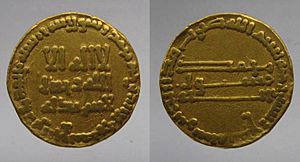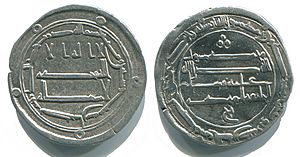Al-Mahdi facts for kids
Quick facts for kids Al-Mahdiٱلْـمَـهْـدِي |
|||||
|---|---|---|---|---|---|
| Khalīfah Amir al-Mu'minin |
|||||

Gold Dinar of Al-Mahdi
|
|||||
| 3rd Caliph of the Abbasid Caliphate | |||||
| Reign | 6 October 775 – 24 July 785 | ||||
| Predecessor | Al-Mansur | ||||
| Successor | Al-Hadi | ||||
| Born | 744 or 745 Humeima, Bilad al-Sham (modern-day Jordan) |
||||
| Died | 24 July 785 (aged 40–41) | ||||
| Burial | Masabadhan | ||||
| Consorts |
List
|
||||
| Concubines |
List
|
||||
| Issue |
|
||||
|
|||||
| Dynasty | Abbasid | ||||
| Father | Al-Mansur | ||||
| Mother | Umm Musa Arwa bint Mansur al-Himyari | ||||
| Religion | Islam | ||||
Al-Mahdi was an important leader in Islamic history. His full name was Abu Abdallah Muhammad ibn Abdallah al-Mansur. He was born in 744 or 745 AD. He is best known by his special name, al-Mahdi, which means "the Guided One."
Al-Mahdi became the third Abbasid Caliph in 775 AD. A caliph was a ruler of the Islamic empire. He took over after his father, Al-Mansur, who was also a famous caliph. Al-Mahdi ruled for ten years until his death in 785 AD.
Contents
Early Life and Rise to Power
Al-Mahdi was born in a village called Humeima, which is in modern-day Jordan. His mother was Arwa, and his father was Al-Mansur. When Al-Mahdi was ten, his father became the second Abbasid Caliph.
To help Al-Mahdi become a strong leader, his father built East Baghdad. This new area had a mosque and a royal palace. A powerful family called the Barmakids also helped pay for buildings there. This area became known as Rusafa.
When Al-Mahdi was about 15 years old, he was sent on important military missions. He helped put down rebellions in places like Greater Khorasan and Tabaristan. These victories helped the Abbasid Caliphate gain more control over these areas.
In 762 AD, Al-Mahdi became the governor of the eastern part of the Abbasid empire, based in Ray. It was there that he met Al-Khayzuran, who later became a very important person in his life. They had several children, including two sons who would later become caliphs: Al-Hadi and Harun al-Rashid.
Al-Mahdi's Rule as Caliph
Al-Mahdi became caliph in 775 AD after his father, Al-Mansur, passed away. His rule began peacefully, which was unusual for that time. He continued many of his father's policies.
One of Al-Mahdi's first actions was to release political prisoners. He also worked to improve and decorate holy sites in Mecca and Medina. He built fountains and places for pilgrims on their way to Hajj.
Al-Mahdi also made many improvements to the government. He expanded the mail service and made the secret service stronger. He also added more judges and removed old laws that were unfair to non-Arabs. He was known for his generous donations to charity.
During his reign, the Abbasid government became closer with the Alids, another important group. The powerful Barmakid family also gained more influence. They worked closely with Al-Mahdi to help the Abbasid state grow and prosper.

Al-Mahdi ruled for ten years. He was interested in music and poetry. Many musicians and poets received his support. His son, Ibrahim ibn al-Mahdi, and his daughter, ‘Ulayya bint al-Mahdī, were both known for their musical and poetic talents.
In 775 AD, an envoy from the Byzantine Empire visited Baghdad. This visitor, named Tarath, was an engineer. He offered to build a special mill that would make a lot of money. The mill worked just as he predicted, and Al-Mahdi was so pleased that he gave all the profits to Tarath.
Al-Mahdi also focused on fighting the Byzantines. He expanded the Abbasid control from Syria to the Armenian border. He also took control of Tarsus, an important city that connected different regions.
In 777 AD, Al-Mahdi named his son, Musa al-Hadi, as his successor. He made sure that important leaders supported this decision. He also put down other rebellions, like one led by Abdullah ibn Marwan in Syria.
Al-Mahdi took his son Harun al-Rashid on two important military trips in 779 and 781. He was teaching and training Harun to be a future caliph, just as his own father had trained him.
Al-Mahdi died in 785 AD. One story says he was poisoned. Another story says he fell off his horse while hunting. He was about 40 or 41 years old when he passed away.
Culture and Government
The city of Baghdad grew a lot during Al-Mahdi's time. People from many different places moved to Baghdad, including from Arabia, Iraq, Syria, Persia, Afghanistan, and Spain. Baghdad became home to people of different religions, like Christians, Jews, Hindus, and Zoroastrians, as well as a growing Muslim population. It became one of the largest cities in the world.
Al-Mahdi continued to expand the Abbasid government. He created new departments for the army, official records, and taxes. He also appointed many new judges.
An important invention during this time was paper, which came from China. Before this, people in the West used papyrus or vellum. Paper was cheaper and lasted longer. This helped the Abbasid government grow because it made record-keeping much easier. A whole street in Baghdad became famous for selling paper and books.
Al-Mahdi also had some important religious policies. He tried to stop the spread of certain beliefs that he considered heresies. He believed that the caliph had the duty to define what was the correct Islamic belief.
Al-Mahdi was not as careful with money as his father, Al-Mansur, had been. He liked to enjoy life and often spent time at Al-Rusafa. He also allowed his wife, Al-Khayzuran, to help with government matters. When he traveled for the Hajj pilgrimage, he did so in a very grand way, even bringing ice from far-off mountains to keep his drinks cold.
There is a famous story about Al-Mahdi while he was hunting. He got separated from his group and found a poor Bedouin's tent. The Bedouin offered him food and drink. Al-Mahdi, without revealing his true identity, kept telling the Bedouin he was someone more important each time he asked. First, he said he was a servant of the caliph, then a general. Finally, he said he was the caliph himself! The Bedouin, thinking Al-Mahdi was joking, refused to give him more wine, saying he might next claim to be a prophet!
Family Life
Al-Mahdi had a large family. His first son who survived was named Abbasa. His wife, Al-Khayzuran, was very important to him. She was the mother of two future caliphs, Al-Hadi and Harun al-Rashid. She also had a daughter named Banuqah. Al-Khayzuran was Al-Mahdi's favorite wife.
Al-Mahdi also married Raitah bint al-Saffah in 761. She was the daughter of the first Abbasid Caliph, al-Saffah. They had two sons, Ubaydallah and Ali.
Another of his wives was Asma, who was Al-Khayzuran's younger sister. He also had other wives and many children, including Ibrahim and Ulayya, who were both known for their artistic talents.
See also
 In Spanish: Al-Mahdi para niños
In Spanish: Al-Mahdi para niños

